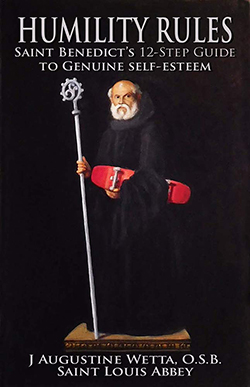In “Humility Rules,” Benedictine offers a different kind of self-improvement plan

Reviewed by Nancy Piccione
The members of my family, God bless them, have to put up with me sharing so many personal development tips, tricks, and hacks.
I really, truly enjoy books, articles, and podcasts about ways to improve one’s time management, relationships, energy levels, and much more. If you’re a person like me, you know what I mean, and how much you love to share what you are learning.
But depending on the source, there is something missing from “self-improvement” references, and I try to incorporate Catholic belief and practice into these often helpful guides. (That is why a book like “The Mindful Catholic” is especially helpful, integrating our Catholic faith and practice with evidence-based information about the benefits of mindfulness, because God made us that way.)
A recent book that integrates these themes well is the engaging and well-written “Humility Rules: Saint Benedict’s Twelve-Step Guide to Genuine Self-Esteem,” by Benedictine Father J. Augustine Wetta. A monk of St. Louis Abbey in St. Louis, Father Wetta is a longtime writer and teacher.
KEY TO HOLINESS, HAPPINESS
Self-improvement gurus might recoil at the word “humility” in the title, but rightly understood, it is the key to holiness and happiness.
As Father Wetta writes, humility is “not focused on the self at all, but on how to relate to one another and to God in light of our strengths and weaknesses. . . . (S)uch clarity of vision begins to develop only when you take the focus off yourself and devote yourself body and soul to a higher purpose. . . . Genuine self-esteem is a form of holiness.”
What makes “Humility Rules” so refreshing and versatile is a keen sense that what is most important in “personal improvement” is not one’s self, but a dependence on God; healthy awareness of our own shortcomings; a willingness to keep trying; and optimism and confidence in that knowledge.
“Humility Rules” is a modern take on “The Rule of Saint Benedict,” the famous 6th-century plan of life for monks. Since that time, countless religious communities have used “The Rule” as a basis for their communal life. Even families and small groups use “The Rule” to help organize their lives along Christian and practical human principles.
At first glance, “Humility Rules” seems to be the antithesis of the self-improvement or personal development genre.
Indeed, Father Wetta’s modern description of St. Benedict’s “Ladder of Humility” begins with rules that are the opposite of the typical, Disney-movie type advice. For example, Step 2 is “Self-Denial,” and its description is “Don’t be true to yourself.” And Step 3, “Obedience,” is “Don’t follow your dreams.”
But that’s what makes “Humility Rules” so refreshing and versatile: a keen sense that what is most important in “personal improvement” is not one’s self, but a dependence on God, healthy awareness of our own shortcomings, a willingness to keep trying; and optimism and confidence in that knowledge.
READABLE, QUOTABLE
“Humility Rules” structures itself around St. Benedict’s “Ladder of Humility” (a chapter within “The Rule”), 12 virtues that help promote holiness and flourishing.
Each chapter covers a virtue, with stories and thoughts about the virtue in thought, word, and deed.
Father Wetta’s style is conversational and accessible without being too simplistic, likely because of his work as a high school teacher and coach.
This highly readable quality makes the book ideal for young people; or — let’s be honest — for many of the rest of us who wish for more manageable reading during these COVID days when attention spans have been shortened.
Each chapter section ends with “homework.” So, for instance, in “Fear of God in Deed” the homework reads: “Secretly do someone else’s chores.” In “Perseverance in Thought,” the suggestion is to “spend the whole day without correcting anyone.” The homework offers great small, manageable ideas.
In an unusual twist, “Humility Rules” includes charming illustrations, either a painting or icon, with something unusual added. For instance, on the front cover, St. Benedict is holding a skateboard. In a portion of an illustrated manuscript, a monk is shown speaking on a cellphone.
There are so many good, quotable sentences and passages in “Humility Rules.” Readers who delve into the book will encounter many of those. Here is one from the section “Reverence,” an appropriate “last word” in these strange times:
“Let the name of Jesus be that silver bell for you — a reminder of who you are, where you stand, and what you stand for. Then, in the midst of all the chaos of life, when you start to feel lost, just whisper that name, and it will bring you back to yourself.”
—
 Nancy Piccione edited The Catholic Post’s Book Page for eight years and is now a member of its book review team. A member of St. Jude Parish in Peoria, she blogs at ReadingCatholic.com.
Nancy Piccione edited The Catholic Post’s Book Page for eight years and is now a member of its book review team. A member of St. Jude Parish in Peoria, she blogs at ReadingCatholic.com.





